| ‘ J-PARC News - January 2017 (Issue #141) |
| Message for 2017, From Naohito Saito, Director of the J-PARC Center Greetings Upon Issuing the First J-PARC NEWS of the New Year |
|---|
| We have also created the slogan "Mindful of Others" to promote watching out for the safety of others, not just oneself. In Japanese, the slogan means "being mindful of your surroundings." If you see unsafe behavior, do not hesitate. Say something, and urge the person to consider how the work can be done safely. At a glance, this may seem like meddling, but as an activity which raises the safety consciousness of both the person urging caution and the person being cautioned, this approach is highly regarded, by the experts who conduct safety auditing, as a campaign to be encouraged even more. In this way, we intend to further pursue safety, including users and contractors. |
| Looking to research results, last year we issued a total of 12 press releases. Results achieved through experiments using J-PARC spanned a wide range of areas, including a first step toward elucidation of CP symmetry through the T2K (Tokai to Kamioka) neutrino oscillation experiment, a new ordered state of high-pressure ice, the internal behavior of lithium batteries during charging and discharging, and successful observation of the abnormal behavior of proteins connected with the onset of Parkinson's disease. |
| To share results like these with people in the local community, we invited Professor Takaaki Kajita, collaborator in the T2K experiment and a Nobel laureate, to Tokai Village, and held a talk including a mingling session with elementary and junior high school students. This was such a tremendous success that the venue overflowed. A facility open house was also held for the first time in four years, and this provided opportunities for people from the local community to see the steadily growing J-PARC. |
| For my greeting for this year, I would like to pledge that we will continue our step-by-step efforts to produce even greater results with our users, and share them with both the local community and the world. |
| January 4, 2017 Naohito Saito, Director, J-PARC Center |
|
| Discovery of a Positive Electrode Material to Help Realize Higher Capacity Lithium Ion Batteries (December 23, Press Release) - Realization of Next-Generation Storage Batteries Expected to Have Effects Such as Boosting Performance of Electric Vehicles - |
|---|
| A research group led by Associate Professor Naoaki Yabuuchi of Tokyo Denki University has successfully developed, as an electrode material for lithium ion batteries, a new electrode material to help realize higher capacity, composed of general-purpose elements and using oxidation-reduction of oxygen for the charge/discharge reaction. This result was obtained through experiments using the large synchrotron radiation facility SPring-8, the photon factory of the High-Energy Accelerator Research Organization (KEK), and neutron beamline BL09 "Special Environment Neutron Powder Diffractometer" (SPICA) in J-PARC's Materials and Life Science Experimental Facility (MLF). This research was supported in part by Specially Promoted Research for Innovative Next-Generation Batteries of the Japan Science and Technology Agency (JST), and on December 23 was featured in "Nature Communications," a scientific journal of the Nature Publishing Group. |
| |
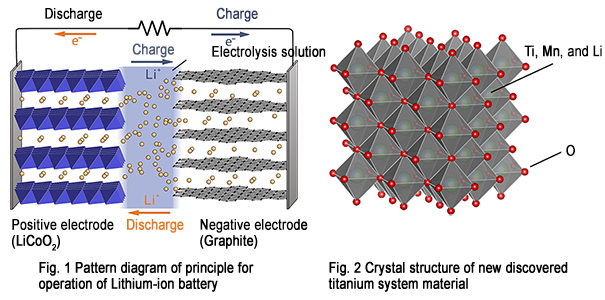
 * Click here to enlarge. * Click here to enlarge. |
| |
| £to Page Top |
| |
|
| Closing in on the Mystery of Light Elements in the Core During the Earth's Formation - In Situ Observation Using Neutrons of Hydrogen Dissolution into Iron - (January 13, Press Release) |
|---|
| A team led by Riko Iizuka, Specially-Appointed Professor at the University of Tokyo (affiliated with Ehime University at the time of this research), in joint research with Takuo Okuchi, Associate Professor at Okayama University, and Principal Researcher Takanori Hattori and Assistant Principal Researcher Asami Sano of the Neutron Science Section of the J-PARC Center, Japan Atomic Energy Agency (JAEA), demonstrated experimentally that, in the initial stage of the earth's formation, it is possible that hydrogen dissolved earlier than other light elements in the earth's core, which is composed primarily of iron. This result was obtained thanks to a new high-pressure assembly developed for this work which can keep samples containing water modeling the primordial material (material at the beginning of the earth's formation) at high temperature and pressure for a long time in the BL11 High-Pressure Neutron Diffractometer (PLANET) at J-PARC's Materials and Life Science Experimental Facility (MLF). These results were featured in the online version of Nature Communications on January 13. |
| |
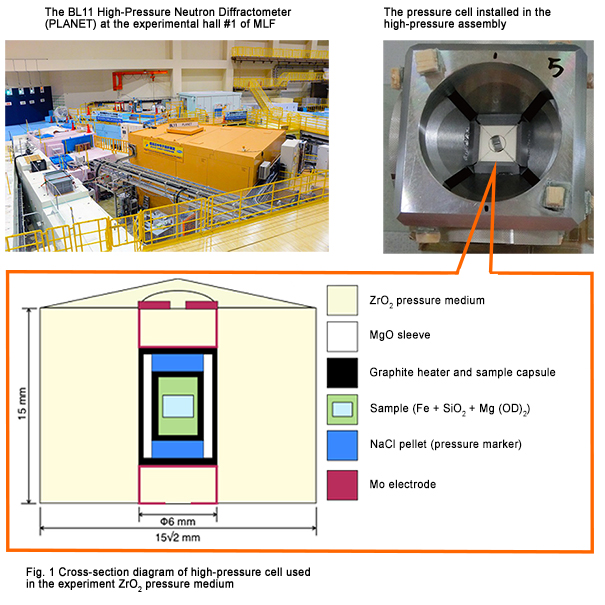
 * Click here to enlarge. * Click here to enlarge. |
| |
| £to Page Top |
| |
|
| Held 23rd J-PARC PAC (January 11-13, J-PARC) |
|---|
| From January 11 to 13, the J-PARC Program Advisory Committee for the Nuclear and Particle Physics Experiments at the J-PARC Main Ring (J-PARC PAC) was held with 15 committee members, including eight from overseas. This committee reviews nuclear and particle physics experiments conducted primarily using J-PARC's 50 GeV Synchrotron (MR), and agenda items of this meeting included reports on the current status and future outlook for J-PARC facilities, confirmation of progress of experiments conducted at the Neutrino and Hadron Experimental Facilities, and review of whether to adopt new proposals. In an open session extending from the first to the second day, many facility staff and users packed the venue, and the committee listened to presentations including more than 20 experiment proposals. |
| |
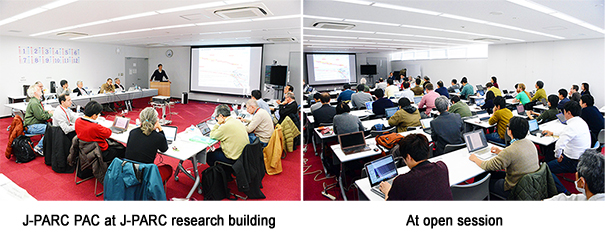
 * Click here to enlarge. * Click here to enlarge. |
| |
| £to Page Top |
| |
|
| Held KEK Public Lecture "The Origin and History of Matter as Revealed by J-PARC" (December 10, KEK Tsukuba) |
|---|
| On December 10, the second KEK Public Lecture of fiscal 2016 was held at the KEK Tsukuba Campus, with the title "The Origin and History of Matter as Revealed by J-PARC." Appearing as speakers from the J-PARC Center were Dr. Toshiya Otomo (KEK Professor) of the Neutron Science Section, and Dr. Takeshi Komatsubara (KEK Professor), Deputy Head of the Particle & Nuclear Physics Division. |
| Dr. Otomo's talk was titled "The Big Role of the Smallest Element: The Science of Hydrogen," and he spoke, while incorporating demonstrations, on the subject of hydrogen, the simplest atom and the first to be formed in the universe. He discussed topics such as hydrogen's proportion in the natural world, its scientific properties, and the mechanism of fuel cells for electric vehicles which run using hydrogen as an energy source, an area of ongoing research at J-PARC. |
| Next, Dr. Komatsubara gave a lecture entitled "The Amazing Story of Curious Quarks: The World of Atomic Nuclei and Elementary Particles." He gave an overview of the various particles produced by the cosmic rays which rain down onto the earth from space. He also described research, currently in progress at J-PARC, on the K meson in particular, known as a "strange" particle which is slow to decay, and research on atomic nuclei which may help elucidate neutron stars. Using numerous photographs, he explained the situation of the assembly of instruments for the KOTO experiment he is involved in for observing the decay of the K meson. |
| There was a lively question-and-answer session with the audience which packed the venue, and some participants continued to ask questions even after the event was over. |
| |
| £to Page Top |
| |
|
| The 37th REIMEI Workshop on Frontiers of Correlated Quantum Matters and@Spintronics (January 13-17, Tokai-mura Industry and Information Plaza "iVil" and other sites) |
|---|
| From January 13 to 17, the Advanced Science Research Center (ASRC) of the Japan Atomic Energy Agency (JAEA) held the 37th REIMEI Workshop together with University of Tokyo, Columbia University (U.S.), and the J-PARC Center. This workshop was held by moving the venue between ASRC, the J-PARC Center, iVil, and the University of Tokyo, and there were 95 participants overall. |
| On the first day, the 13th, Shoji Nagamiya (previous Director of the J-PARC Center) and Naohito Saito (current Director) gave talks to about 40 participants, made up of graduate students and young researchers, providing an overview of state-of-the-art research using quantum beams, and introducing the current status and future outlook for experiments/research being conducted at J-PARC. There was also a tour of J-PARC facilities, and the participants attentively listened to explanations by the researchers in charge of the COMET experiment planned for the Hadron Experimental Facility, and the neutron and muon experiments at the Materials and Life Science Experimental Facility (MLF). |
| |
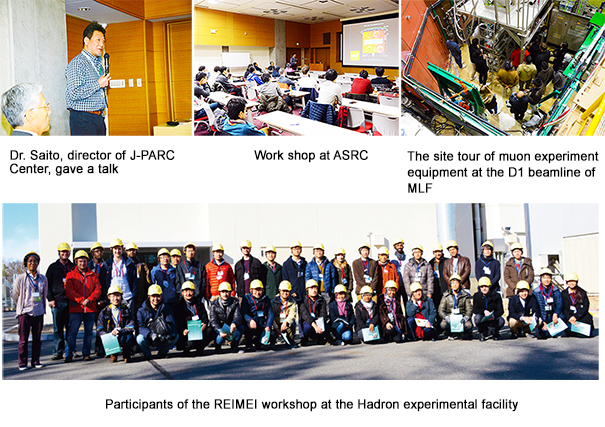
 * Click here to enlarge. * Click here to enlarge. |
| |
| £to Page Top |
| |
|
| J-PARC Hello Science "Chocolate Science" (January 21, Aeon Tokai) |
|---|
| In December of last year, the J-PARC Center launched a series of J-PARC Hello Science events to deepen interaction between researchers and the local community. The venue for these events is the food court of Aeon Tokai, located in front of JR Tokai Station. |
| At the second gathering on January 21, Dr. Norifumi Yamada of the Neutron Science Section of J-PARC Center took on the role of instructor, and we held* a "Chocolate Science" event for scientifically considering the deliciousness of chocolate from the standpoint of crystal structure, and experiencing how the deliciousness changes with different methods of making chocolate. There were 20 participants, ranging in age from children to adults. In the area around the venue, shoppers were seen to stop and watch the event with great interest. |
| The talk discussed the fact that the deliciousness of chocolate is perceived through the senses of vision, touch, and taste, as well as mouthfeel, and those differences are due to the crystal structure upon cooling and hardening of (cocoa butter) in the ingredients melted when making chocolate. After that, the participants were divided into pairs, and they took up the challenge of making three types of chocolate with different preparation methods. They experienced the differences in mouth-melting, taste, mouthfeel and other characteristics of the chocolate finished by cooling in a refrigerator, and many excited comments were heard from among the participants such as "this one's sweet" and "this one's hard" and so forth. The impressions from their taste comparison were summarized in a graph, and critiqued by Dr. Yamada. He also explained that synchrotron radiation (X-ray) experiments and neutron experiments (J-PARC) have verified that differences in deliciousness are due to the crystal structure of chocolate. |
| J-PARC Hello Science received support from Tokai Village this time, and going forward the plan is to continue holding these events primarily at Aeon Tokai, while varying the topic each time. Details on each event, such as the schedule and content, will be disseminated via the J-PARC home page, posters, and other media. Everyone is welcome, so feel free to drop by. |
| *Co-organizer: Institute of Material Structure Science, High-Energy Accelerator Research Organization (KEK) Support: Tokai Village, Tokai Village Board of Education, Cooperation: Tokyo Food Co., Ltd. |
| |

 * Click here to enlarge. * Click here to enlarge. |
| |
| £to Page Top |
| |
|
| Winners of the J-PARC FY2016 Photo Contest (December 20, J-PARC) |
|---|
| The J-PARC Center held Photo Contest 2016 for everyone engaged in research and work at our facilities. Photos were solicited on themes such as eye-catching equipment, processes or results of research, and people in action operating equipment in facilities, and this time we received 64 photos, greatly surpassing the two previous events*. Ten winners were selected based on an impartial review by a judging committee, and a photo by Dr. Stefanus Harjo of the Neutron Science Section was chosen as Best Photo. Dr. Harjo is one of the managers of the neutron beamline BL19 "Engineering Materials Diffractometer (TAKUMI)" of the MLF, and the winning photo showed an experimental specimen at high temperature. In environments where experiments and other work are carried out, there are situations where very beautiful events occur if you look at them in a different way, and Dr. Harjo's photo was rated highly for capturing a moment with good timing. On December 22, contest winners were presented with their awards, and the photos will be displayed at the stairs of the J-PARC Research Building until the next contest. |
| Through these winning photos, we present a world of beauty characteristic of experimental facilities. Please see the following URL.http://j-parc.jp/PhotoCon/2016/index_e.html |
| *The Photo Contest was started in 2012, and held in 2015 and 2016. |
| |
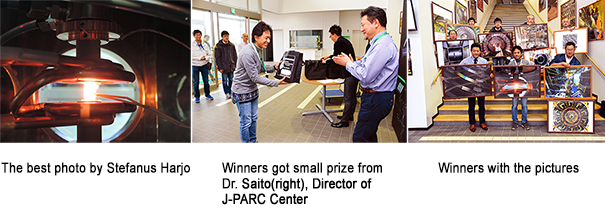
 * Click here to enlarge. * Click here to enlarge. |
| |
| £to Page Top |
| |
|
©2017 J-PARC Center. All rights reserved.
|
|